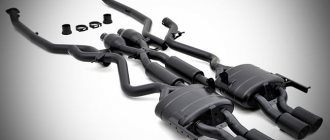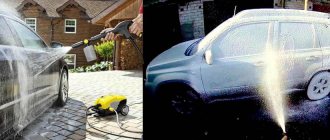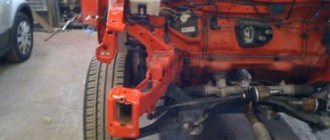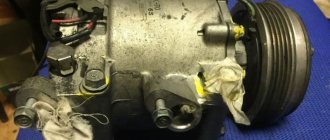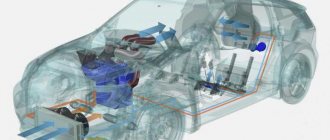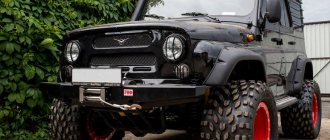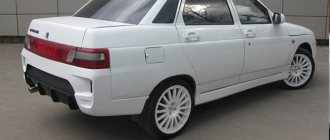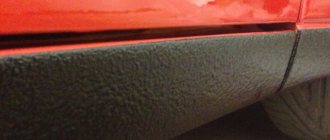Repost and the information will always be at hand ✅
Silent blocks are separate structural elements that in appearance resemble an ordinary bushing or piece of hose. Rubber-metal hinges are securely inserted and fixed into a metal cage.
The silent block together with the shock absorber reduces vibration and noise levels when the car is driving on poor-quality roads, of which there are many in Russia. These elastic parts are also used in bicycles and motorcycles.
The element is located in the upper and lower arms of the front suspension, in the rear connection of the steering mechanism with the rod. Despite the simplicity of its design, the silent block is very important for the car. Therefore, if a car repair shop recommends that you replace them, then do not think that they just want to scam you. Read the article and you will have complete information about the silent blocks of the car.
This element is important for the safety of the car during its operation and ensures driver comfort. The wear of the element is detected during a routine technical inspection; in such cases, replacement is required.
In the article I will tell you in detail what silent blocks are, the principle of operation, the device, what types there are, how to identify the fault and replace it, as well as an overview of the best manufacturers. I promise it will be interesting!
What is a silent block, what is it responsible for?
Translated from English, silent block is translated as a quiet block - “silent block”. Not all car owners know what this element of the car looks like and how it works, although without them, driving a car would be very uncomfortable.
The idea of creating a single structure of metal and rubber, which would reduce vibrations and shock loads when moving a car, appeared in the head of Walter Chrysler, after whom the company of the same name was named. But the name of the person who developed the part has been lost.
In February 1932, in the New Finer Plymouth car, rubber-metal joints were installed in the engine suspension for the first time, which caused a lot of joy - vibration became much less. After 20 years, hinges were already installed on all car models everywhere. It is interesting that the very first rubber-metal hinge was also the first silent block, because it was non-removable - the rubber insert was motionless.
1932 New Finer Plymouth
In cars, the silent block ensures an elastic connection of suspension units and protection of the body during movement, shock and vibration. Due to the operation of the structural element, the comfort of using the vehicle for the driver and passengers increases.
This element allows you to prevent early wear of other, more expensive elements. The module is used to absorb the impact of loads generated during vehicle movement, transmitted to the body and load-bearing parts of the suspension.
Rubber-metal hinges (RMH) are often called silent blocks, but if you study the terminology, this is not entirely incorrect. In general, rubber-metal hinges are either collapsible or non-removable. So, a silent block is a non-separable RMSH with two metal bushings, between which there is an elastic rubber (rubber) or polyurethane insert-damper. The sleeve and insert are “seated” with glue or vulcanized, and then the pressing procedure is carried out. The part turns out to be reliable and can withstand up to 100 thousand kilometers.
Silent blocks are installed between the body and suspension elements to reduce noise and transmitted vibration. This technology allows you to increase the load-bearing capacity and increase the service life of the unit. This is the difference between silent blocks and rubber-metal hinges.
In a conventional RMS, the immobility of the rubber is ensured by preload and radical compression during the installation process. Over time, this state is disrupted, the element fails and produces characteristic sounds - squeaking. And the state of the silent block cannot be controlled in this way; it will remain “silent” until the last moment. Even when external signs of wear appear, slipping, squeaking and other sounds do not appear. As a result, the elastic breaks instantly.
Most often, silent blocks are installed in the front suspension of the car to attach the arms and anti-roll bar (rod).
What does the anti-roll bar look like?
What is the silent block responsible for?
- Connects vehicle suspension components.
- Reduces noise inside the car while driving.
- Vibrations and impacts to the body when driving on bad roads are absorbed.
- The vehicle's stability increases.
- Protecting expensive parts from rapid wear.
Installing silent blocks reduces the final cost of cars - thanks to them, the rules for fitting parts are not so strict.
Instructions for replacing the silent blocks of the lower and swing arms
The front control arm silent blocks are replaced as follows:
- The car must be parked in a pit. If the VAZ 2110 has engine compartment protection, it must be removed. Next, remove the nuts from the bolts that hold the front arms. Then you can unscrew the nuts of the bolts connecting the lever and the stabilizer. After removing the wheel bolts, the car must be jacked up and the wheel removed;
- Armed with a “24” wrench, you need to unscrew the nuts of the braces. If the fasteners do not lend themselves, they must be treated with WD-40. After removing the nut, the steering knuckle and ball joint can be separated. The front arm can now be completely removed;
- Done, now the faulty silent blocks can be removed. Next, you should take the new parts and press them into the lever using a vice. First you need to install the silent blocks of the brace. It rarely happens that the block is completely seated in the lever; this can be corrected with a few blows of the hammer;
- The next step is to press in the silent blocks of the levers. If the part is completely worn out, it will fall out after hammer blows. The new part must be lubricated before installation in the lever. As the experience of VAZ 2110 owners shows, it is best to lubricate with soapy water or liquid soap. Done, replacement complete, reassemble in reverse order.
Advice! It can be very difficult to unscrew the nut of the extensions, so it is better not to spend 10 minutes on each turn of thread, but to dismantle the lever together with the extension.
The principle of operation of the silent block
When moving, the car is exposed to various negative factors (shocks, vibrations, loads, vibrations). Friction occurs at the mounting points of the suspension parts, resulting in poor performance. Plastic silent blocks are designed to prevent such a change. The principle of their operation is to reduce friction between chassis parts and absorb vibrations and shocks in all directions. That is, the elastic element dampens vibrations.
When the hinge is subjected to twisting, its destruction does not occur, this is due to the correct calculation of the unit. Most often, silent blocks are subjected to rotation between metal cages, but sometimes it is used for bending, when an elastic part is placed on suspension arms with a vertically oriented axis.
See how the silent block works in motion on a Honda CRV:
If a rubber-metal hinge is installed in the traverses and mounting eyes of transmission parts, then here it acts as a kind of gasket between them and the car body.
Due to the very tight connection of the elements, unnecessary movements of the lever are limited. There are no gaps, and therefore vibration and knocking when moving the car are reduced.
How many silent blocks are there in the rear and front suspension of a car? If you count the entire number, then there will be more than 8 of them in the front suspension, and more than 12 in the rear. It all depends on the make and model of the vehicle. I note that stabilizer struts, bushings, and tie rod rubber bands are not silent blocks.
The location of the silent block in the car affects how this part can work. It can work:
- Due to the torsion of the bushing.
- By stretching or compressing the bushing.
Another good article: Crankshaft: what is it, where is it located, device, purpose, how it works, photo
MacPherson suspensions often use 2 different silent blocks: one is twisted, and the other connects the body to the lever, giving rigidity to the structure.
The silent block, which is installed on the front lever, is in most cases necessary to reduce vibration on the wheels. And the rear silent block reduces the likelihood of lever misalignment.
Dismantling and installation process
Installation begins after purchasing the parts. You will need a tool - wrenches for removing the beam and suspension arms, a hammer or sledgehammer.
The replacement is complete and you can drive the car immediately. During assembly, you should check the installation of each part and only then proceed with assembling the next one. The silent block of the front beam is changed according to the same scheme.
Dismantling the old gum is done with 3 - 4 strong blows with a sledgehammer. You should hit strictly in the center of the part, without deviating to the side from the vertical axis. The edge of the clip is bent using a chisel to facilitate dismantling.
Experienced craftsmen use a piece of tube to press out the silent block of the rear beam. It is important that its diameter is slightly smaller than the same parameter of the seat. The tube is placed against the part and hit with a hammer. In a few blows the part will be removed without unnecessary operations.
Kinds
Depending on the materials used, silent blocks can be polyurethane or rubber. When dividing adjusted for design features, the following are distinguished:
- designs with one sleeve. This is a classic non-separable element;
- with two bushings;
- with technological holes in the rubber for rotation. This is necessary for the torsion levers to work.
- with internal mounting eyes for bolts. Such parts are asymmetrical;
- made of rubber without metal parts. In this case, the part is attached with glue to the suspension elements;
- floating silent blocks. They are not hinged, but ball-shaped. Their advantage is their ability to provide a smooth ride, speed advantage, acceleration dynamics, braking and increased vehicle controllability. The downside is the accelerated wear of the internal plastic sleeve. These silent blocks are installed in the steering knuckles of the rear suspension.
What types of silent blocks are there depending on the rigidity of the fastening:
- ensuring permissible suspension vibration;
- allowing a large range of movement.
The main factor that you should pay attention to when choosing a part is the material of manufacture. It is this that ensures the quality of the part and allows us to evaluate it according to the main criteria: quality, long service life, reliability. When choosing a silent block, you must take into account the nature and intensity of use of the car.
Despite the recommendations listed, experts advise considering polyurethane silent blocks. The only drawback revealed when comparing them with rubber ones is their high cost. But it is compensated by reduced wear.
In the production of silent blocks, two materials are used, which are distinguished by better shock absorption and the ability to dampen vibrations transmitted to the body. These are rubber and polyurethane. Before choosing a quality part, it is worth studying the features of each type.
Rubber
Only in the last 10 years have car owners been puzzled by the question of which silent blocks are better, rubber or polyurethane. Up to this point, only one material was used - rubber, and there were no significant problems.
Rubber, compared to polyurethane, has a number of advantages:
- the cost is approximately 2-3 times lower than that of polyurethane;
- no maintenance or lubrication required;
- softness - rubber is optimal for those who like a measured and comfortable ride.
However, for certain regions of Russia, rubber silent blocks are not the best choice. Rubber reacts poorly to temperature fluctuations and can crack in the cold.
The key disadvantage of silent blocks made of this material is reduced safety. The level of this indicator directly depends on the rigidity of the material - the elastomer. If it is high, controllability increases. Also, the rubber elastic element can squeak and wear out quickly. To reduce wear, do not overload the machine, drive less aggressively, and prevent the ingress of oil and chemicals.
The elastomer, which has the best properties for reducing vibrations, is made from natural rubber.
Polyurethane
Repairmen often recommend to their clients replacing rubber silent blocks with polyurethane ones. This will improve the suspension performance and handling of the car. The popularity of these elastic parts is due to the following advantages:
- extended service life compared to rubber by 5 times or more (approximately 200 thousand km). I note that perhaps this is just a publicity stunt, since no one has tested this, but they will definitely last 2 times longer;
- “behave” better on poor road surfaces;
- lack of reaction to contact with oil and chemicals that are used to spray roads in winter;
- possibility of increasing suspension rigidity;
- when installed correctly, shocks and vibrations are better absorbed and noise is reduced;
- There is no “squeezing” effect, which is present in rubber parts.
- durability, reliability and safety.
But the material cannot be called ideal. Often during operation, car owners identify some shortcomings:
- a significant increase in rigidity indicators;
- poor fit to the bushings;
- peeling of polyurethane;
- high price.
The presence of the listed disadvantages does not allow us to call the polymer material ideal for the manufacture of silent blocks. By some criteria it is inferior to time-tested rubber, but by others it is superior to it.
Right choice
The choice is made after diagnosing the malfunction or during a planned replacement. It is necessary to understand what role the part plays in the suspension. Its task is to dampen vibrations that inevitably arise due to unevenness on the road.
Vibrations during movement are transmitted to the suspension springs, where they are partially damped by shock absorbers. The vibration then spreads to the frame through the connecting nodes. It is partially damped by silent blocks due to the presence of a soft base between the bushings. Therefore, the quality of the base must be of a high level. The factory version of the suspension is equipped with rubber-based silent blocks. This is a proven material, but there are better ones - for example, polyurethane.
Rubber and polyurethane are equally popular. Drivers themselves choose what to focus on. With rubber spacers you can get increased riding comfort, but improved handling can only be achieved with polyurethane. But in the latter case, comfort decreases, which is especially felt by passengers.
Which silent blocks are better: polyurethane or rubber?
To improve handling and dynamics, it is necessary to install polyurethane silent blocks. And if you prefer a calm, measured ride, then it is better to install rubber-metal elements.
The majority of car owners are now trying to install polyurethane silent blocks, justifying their choice with their increased strength and reliability. Of course, rubber is also not without this drawback, but it is compensated by the 2-3 times lower cost of the material.
When considering the advantages of a polymer material, they become its disadvantages. Increased hardness, which enhances safety, changes the ride character, making it more rigid. Reduced plasticity increases the load and causes the silent block to operate in places where the rubber does not react.
Attention! It is impossible to call polyurethane RMS the optimal choice. The inflated cost is not compensated by wear resistance, because rubber products can be replaced 2-5 times for the same amount.
Watch the video about two tests of polyurethane silent blocks, I think you will be interested.
How to Recognize the Symptoms of Defective Control Arms
So, we found out that the wishbones of the suspension are not protected from aging and wear. The latter, in turn, depends on factors such as age and/or driving style.
But most often this component, like any other part, is subject to wear due to mechanical stress. Damaged wishbones can attract attention (even among inexperienced drivers) primarily due to deteriorated vehicle control. Here is a list of common signs that indicate your control arms need to be replaced.
Where are the silent blocks located?
The installation location of silent blocks and their number depend on the design features of a particular machine model. As a rule, they are installed:
- in the lower and upper arms of the front suspension;
- on the transverse arms at the points of attachment to the body;
- at the junction of the anti-roll bar to the lever;
- at the bottom of the shock absorber struts for attachment to the hub;
- in places where the torsion beam is attached to the body;
- at the points of attachment of jet rods;
- on the support beams of the internal combustion engine and gearbox;
- at the connection between the steering mechanism and the rod.
The structural element is often used to mount shock absorbers, gearbox and engine. The condition of all components should be carefully monitored. If the car begins to respond to turning the steering wheel with a slight delay, it is worth checking the rubber-to-metal joints.
Replacing silent blocks of VAZ 2110 levers: necessary tools
To work you will need the following tools and equipment:
- Puller.
- A set of keys.
- Screwdriver Set.
- Hammer.
- Vise.
- Chisel.
- WD-40.
- Inspection hole and jack.
A puller is the most important tool, since dismantling and replacement of silent blocks cannot be done without a puller. You can buy the device or make it yourself. The puller consists of a wide and thick washer, a tall nut, an M12 bolt and a sleeve, the length of which is 60 mm and the internal diameter is 38 mm.
Signs of trouble
Silent blocks are a consumable material for the vehicle chassis, ensuring safe operation of the vehicle. They significantly improve ride comfort and handling. The condition of the RMSh should be periodically monitored, and you should also know the reference (limit) resources of this important spare part.
Most often, the wear resistance of consumables is determined in kilometers. On good roads, a high-quality part can last up to 100 thousand km. These indicators for Russia require significant adjustments. It is worth checking the condition of silent blocks every 50-60 thousand km. But in practice, the silent block rarely breaks.
The following signs help to promptly identify the need for work to replace a part:
- the car is unstable to drive;
- the steering wheel turns noticeably slower;
- noise comes from the suspension when driving on poor quality road surfaces;
- The direction of movement is unstable, the car is moving to the side. The worse the road, the more the car “throws”;
- the steering wheel vibrates;
- creaks and other extraneous noises occur;
- tire wear occurs unevenly, characterized by rapid wear of rubber on one side;
- Wheel alignment indicators do not correspond to normal conditions.
Another good article: Car shock absorber: what it is, how it works, design, types, diagram
The need for regular inspection and timely replacement of the element should not be neglected. Driving safety depends entirely on it.
The resulting malfunction can cause the car to suddenly pull away at speed, which will result in disastrous consequences.
Replacement only assembled
The big advantage of these units is that they do not require maintenance. During the operation of the car, you just need to periodically monitor the condition of the hinges. When they are in good working order, there is no friction inside the structure or contact with metal, so if used correctly they last quite a long time.
Silent blocks are characterized by a non-separable design, so they can only be replaced when assembled. The cost of these parts is quite affordable, so there is no point in saving on repairs.
When replacing a rubber-metal joint, it is important to adhere to certain rules. The main thing is to tighten all connections under load. In this case, the machine must have its wheels on the ground.
Each car uses several types of hinges. For example, the camber arm bears virtually no load, so it can be repaired. In other cases, it is better not to take risks, since the wear of more expensive suspension elements depends on the serviceability of this unit. A repaired hinge will not be able to perform its functions 100%.
How to check silent blocks
The technical condition of silent blocks can be determined on overpasses, lifts or using an inspection hole. To carry out the work, you need to have a general idea of the appearance of the part and its dimensions. For diagnosis, special tools are needed, and if they are not available, it is better to contact a service station.
When checking the silent block, they evaluate its condition, confirm or refute the integrity of the part. According to the standard, a serviceable element should not have breaks or gaps in connections.
The general diagnostic procedure includes:
- The car is placed on the overpass and prepared for visual inspection; the parts are cleaned of dirt and dust.
- A visual assessment of the condition is carried out.
- Remove the ball joints.
- Assess the condition of parts whose work is related to silent blocks. They look at how the left axle and the rear beam “behave.”
- By loosening the suspension arm and returning it to its original position, springback is assessed. If it is present, the silent block is in order.
- If the part is torn, then the levers are placed a little crookedly.
- The bushing position is assessed. It should not rotate freely.
- They inspect the silent block itself, rule out the presence of knocks inside the part itself, and check whether there are cracks or other deformations on its surface.
- Using a mounting blade, play in the silent block is eliminated. If it is detected, emergency replacement of the part is required.
The silent block diagnostic procedure is simple for professionals. Beginners often make mistakes due to insufficient knowledge of vehicle design.
Attention! Untimely replacement of consumables is fraught with consequences. The driver may lose control while driving. Breakages of the front lever and destruction of the mounting points of silent blocks cannot be ruled out.
Watch a useful video on how to check the chassis of a car.
How to understand when it's time to replace
Before you set out to press in these parts, you should first of all inspect them thoroughly to make sure that they really require replacement. Check for holes and any deformations, for swollen rubber on the hinges and for cracks. Manipulate the components, determining the presence of backlashes. If the permissible norm is exceeded, then replacement of parts is inevitable. It is not recommended to delay the pressing procedure. Over time, this problem will only get worse and can lead to suspension arm failure. The main indicators that indicate the failure of one part or several:
- Driving the car has become much more difficult.
- When overcoming bumps, the suspension begins to knock loudly. Tires wear unevenly, which has not been observed before.
- It has become much more difficult to adjust wheel alignment.
How to extend the life of silent blocks
The silent block is not an elastic suspension element; the elastomer should not be loaded with an average vehicle load. To avoid unnecessary effort, you should not leave the car for a long time with overloaded suspension elements and hanging wheels, as this causes damage to them. In winter, strong swings should not be allowed.
When replacing an element, the position should be carefully verified, because the rigidity of the beam varies markedly along the radius. Not everyone knows what the red inserts in silent blocks are for - they are the ones you should focus on during installation. Oil and other caustic substances must not be allowed to come into contact with the surface; they destroy rubber and polymers.
There is one more primitive tip that allows you to extend the life of the silent block. It needs to be looked after by regularly removing dirt and excess moisture. Under the influence of unfavorable conditions, wear resistance decreases, which may become a reason for unscheduled repairs. Dust can get into microcracks, which will accelerate wear of the part, and frozen water can cause the silent block to rupture.
Periodic use of narrow-profile lubricants designed to restore the surface layer of rubber will be beneficial. But you cannot use special lubricants to eliminate squeaks: this harms the rubber and its adherence to the metal holder.
Watch an interesting video about all the reasons why silent blocks quickly fail:
Components and location
The silent block consists of two metal bushings connected to each other by a rubber insert. Although the modern variety of silent blocks may look different. Depending on the location, it may be on the outside with a metal sleeve, or completely rubber.
The silent block may also differ in the structure of the rubber insert. Depending on the destination, the rubber insert can be solid, ribbed or with vibration damping. The latter, as a rule, are installed in the engine of a foreign car to dampen vibration transmitted from the unit to the car body.
Most silent blocks can be found in the front and rear suspension, more precisely in the levers. Mainly designed to hold movable suspension mechanisms. The front silent blocks are located in the front control arms, hence the name. They bear the most load, as they are responsible for the turning and moving mechanisms of the car.
The rear silent blocks can easily be seen on the shock absorber fasteners, in the rear suspension or on the reaction rod. Wherever there is a body load on the chassis, or where moving parts are connected to fixed mechanisms.
Reasons for failure and what breaks in the silent block
It is quite difficult to visually imagine a critical breakdown of a metal part of a car, because a violation of the silent block is most often a rupture of the rubber part of the element. High-quality silent blocks do not require maintenance, since they do not contain lubrication. Among the reasons that can lead to malfunction are:
- Long-term operation . Natural wear and tear of rubber or polyurethane occurs. The element loses its elasticity and begins to crack, knocking and squeaking noises occur. Additionally, there may be separation of rubber from metal, since vulcanization has its own lifespan. As a result, the bushing slides along the metal cage and wears out, which leads to gaps.
- Chemical exposure . Destruction occurs due to the ingress of oil and chemicals that corrode the elastomer.
- Incorrect installation in the seat. I note that the reason for premature occurrence of problems is when the bolts are overtightened or secured with insufficient force. The fit of the metal clips in the eyes and on the axles may become loose.
It is important to install silent blocks correctly - Incorrect bolt tightening . Remember, you should tighten the bolts when the car is standing on all wheels, and not suspended. If you do not follow this rule, then when lowering the car down, the rubber will twist and soon tear. Some car repair shops do this so that the client comes to them again for a replacement.
- Severe operating conditions . If you load the car too much, the elastomer heats up, gets tired and breaks down many times faster. The same applies to mechanical stress.
A faulty silent block simply stops performing its basic functions. The problem can be detected quite simply by the characteristic sound. When driving with a large range of motion, the impacts will be very noticeable.
What can cause problems with the suspension arm?
Depending on road conditions and mileage, a number of problems can arise with this seemingly powerful and simple design. One of them may be wear of fasteners.
The rubber in silent blocks ages, hardens and cracks. In advanced cases, the rubber bands fly apart, exposing the surrounding metal bushings, the suspension begins to make clicking sounds during operation, and the car turns into a “rattle.”
In addition, over time, ball joints are subject to wear, which also leads to play in the suspension, extraneous sounds and other unpleasant symptoms. And even if you think that the wishbone itself, as a metal structure, cannot become unusable, think twice - it can also be bent or broken, and if the car is very old, it can rot and break.
If the lever is slightly deformed and for some reason the driver does not notice this (he is not bothered by vibrations, deterioration of maneuverability, or the car pulling to the side when moving in a straight line), with the next shock load the bent metal may crack - the lever will break. In this case, deformation of a part can occur not only due to a serious impact (hitting a curb or an open well), sometimes it is enough to fly into a hole or into a speed bump at speed. Side impacts are also very dangerous.
Since the suspension design is programmed for vertical travel, even a small blow from the side can cause serious damage not only to the silent blocks, but also to the lever itself. One of the textbook examples is lateral sliding on ice followed by a collision with a curb stone.
Consequences of untimely replacement
You should not hesitate to replace silent blocks, because the safety and comfort of using the vehicle is noticeably reduced. With significant wear, the car will begin to move to the side, steer itself, and tire wear will accelerate.
Another good article: Car thermostat: what it is, device and principle of operation, types, photos + video
Also, if silent blocks are not securely attached, they can lead to destruction of the hinge mounting locations and deformation in the suspension. This will increase the cost of repairs, since you will additionally have to buy and install the front suspension arm assembly, which will be several times more expensive than replacing silent blocks.
Broken suspension arm
In practice, even the most expensive silent blocks containing the best rubber will not be able to withstand more than one hundred thousand kilometers. The rubber moves away from the metal cage and turns. This can disrupt the geometry of the body, cause unpredictable skidding, and reduce ground clearance. The driver may feel the impact of the suspension on uneven roads. A sharp decrease in controllability is the most dangerous consequence of untimely replacement of the silent block.
Be sure to check the condition of the silent blocks every time you perform chassis maintenance.
Replacing silent blocks on a car - step-by-step instructions
You should prepare for replacing silent blocks.
You will not be able to do without a jack or pit, a kit for replacing parts and the tools necessary to press out the silent block.
- The vehicle is placed in a “pit” (inspection hole) and the crankcase protection, if present, is dismantled.
- We unscrew the nuts that serve to secure the front arms. Use a #17 wrench to unscrew the nut that secures the stabilizer to the lever, and remove the bolt using a hammer (it’s very difficult to remove it manually).
- We tear off the bolts for fastening the front wheel and lift the side of the vehicle we need with a jack, after which we remove the wheel.
- Next comes unscrewing the next nuts - on the braces. You can't do without a shoulder key here. Note: before unscrewing, the nuts should be treated with VD-40 (a substance known to all motorists).
- After that - a ball joint, which is moved away from the rotary cam, and a couple more bolts, after unscrewing which the lever is dismantled.
- Now, using a special device, the silent blocks are dismantled and the eyes are cleaned of dirt.
- Next is pressing in new elements. In the absence of a special kit, a hammer, chisel and Russian ingenuity are used to replace them. But there is a risk of damage to the element or part of it.
- Next, the pressed silent block is lubricated with soapy water and installed in its rightful place. We return everything to its place, but in the reverse order (except for the old silent blocks, of course).
Important!
After replacing the silent blocks, a wheel alignment procedure must be carried out in case something was broken during dismantling.
Of course, if you have talent and minimal knowledge of car design, you can replace the above-described elements yourself.
But if you have the slightest doubt, entrust this labor-intensive procedure to specialists (replacing silent blocks on your own has more than once cost craftsmen a pretty penny). And don’t delay visiting the service station
– safety is more important!
They will help you with replacing silent blocks, where you will find professionals with many years of experience, high-quality modern equipment and affordable prices.
How to properly replace the silent block
When replacing a faulty structural element, certain tools will be required:
- a wrench for removing the suspension arm and beam;
- special press;
- silent block remover.
Attention! Initially, you should choose high-quality silent blocks that will be purchased as replacements.
After installing and fixing the vehicle on the lift, disassembly of the elements is ensured. The silent block of the rear beam is changed according to the following algorithm:
- remove the beam suspension;
- unfasten the handbrake cable;
- release the mounting bracket for the brake system hoses located on the brackets;
- remove the old silent block of the beam using a puller;
- clean the installation site from dust and other contaminants;
- apply graphite lubricant to the installation site;
- ensure the installation of a new part, fixing it without gaps using a hydraulic press or pneumatic tool. Sometimes a sledgehammer is used, but it is better to avoid this so as not to deform the part. The pressing procedure is the most difficult part of the work;
How does the silent block pressing process take place? - elements removed for installation are installed back, observing the sequence;
- After the work, it is imperative to restore the wheel camber and toe angles.
Replacement of the front beam silent block is ensured in compliance with the same principles.
If a structural element is bolted rather than pressed in, its dismantling is ensured by unscrewing. When carrying out installation, you must pay attention to the position of the part, because placing it arbitrarily is unacceptable. If the element has partitions, it functions in two positions. If you ignore the regulatory rules, the load will be distributed unevenly and the silent block will quickly fail.
First and most importantly, the silent block must be tightened when the car is on a flat surface, that is, when it is lowered from the lift. This is due to the fact that when the vehicle is located on a hill, it is almost impossible to tighten the bolts and nuts in the correct position. The parts will be in the wrong position. After the machine is lowered, the rubber bushing will twist as in the loaded position. Accordingly, it will always be in working condition, even without loads. Such an error during replacement is dangerous due to premature wear of the consumable. Only this tightening method is the most correct.
Silent blocks only need to be replaced as an assembly, because this element is non-separable. But sometimes this part is already included in expensive suspension units from the very beginning, so when the silent block wears out, the entire structure must be changed.
The video shows a simple way to replace silent blocks in a car, which does not require special equipment and is accessible to every car owner.
We change it ourselves or contact a service station
To replace the silent block with your own hands
you will need:
- Ball joint remover.
- Jack.
- Device for pressing silent blocks.
- Set of wrenches.
If you don’t have the necessary tool, it doesn’t matter. Everything can be purchased on the automobile market for a symbolic price. All work consists of several stages:
- Using a jack, lift the desired wheel and remove it.
- Unscrew the nut of the upper ball joint. Let's take it off.
- We remove the upper arm and silent block, press a new one into the same place.
- Lubricate the lever axles with grease and screw it into place.
But any experienced motorist will advise turning to professionals. Every car center has a service station where they will not only quickly and correctly replace the part, but also do a wheel alignment afterwards. After the suspension intervention procedure, this must be done so that the car does not “steer” to the side when driving.
Faulty control levers on the front wheels:
– the car pulls to the side when the steering wheel is straight
– steering is unclear or, conversely, very sensitive
– the car begins to yaw, and you have to “catch” it. This is especially felt even in a small rut
– when driving over uneven surfaces, a knocking or grinding sound is heard
– squeaking when turning wheels
– uneven tire tread wear
– the response of the wheels to steering wheel movement is delayed
– rapid wear of the lever joints
